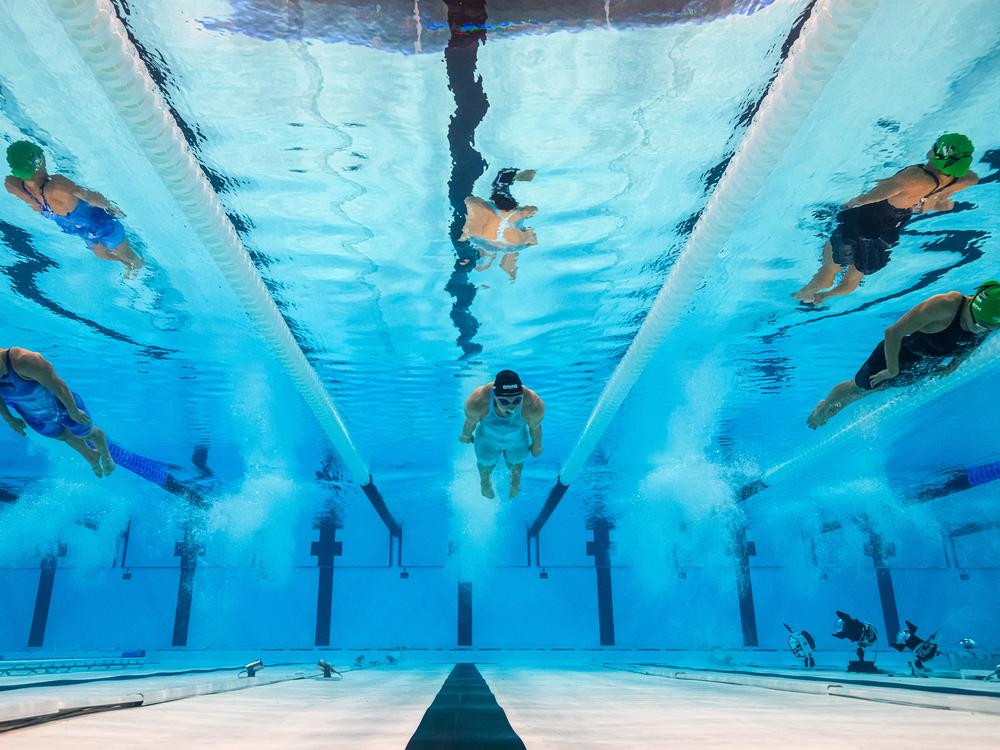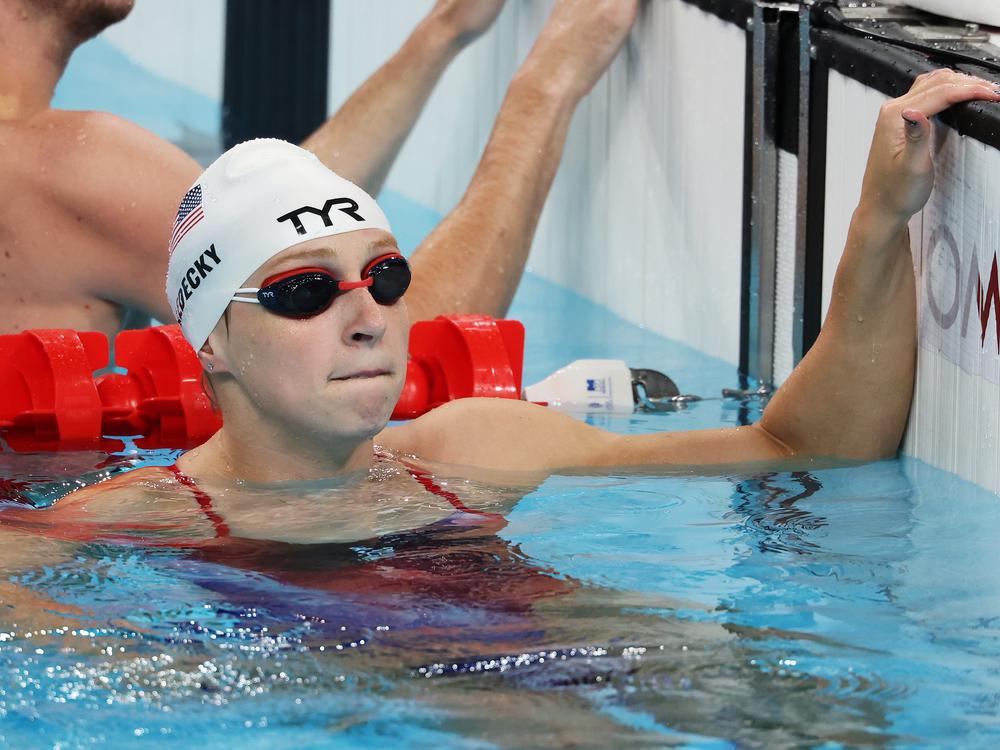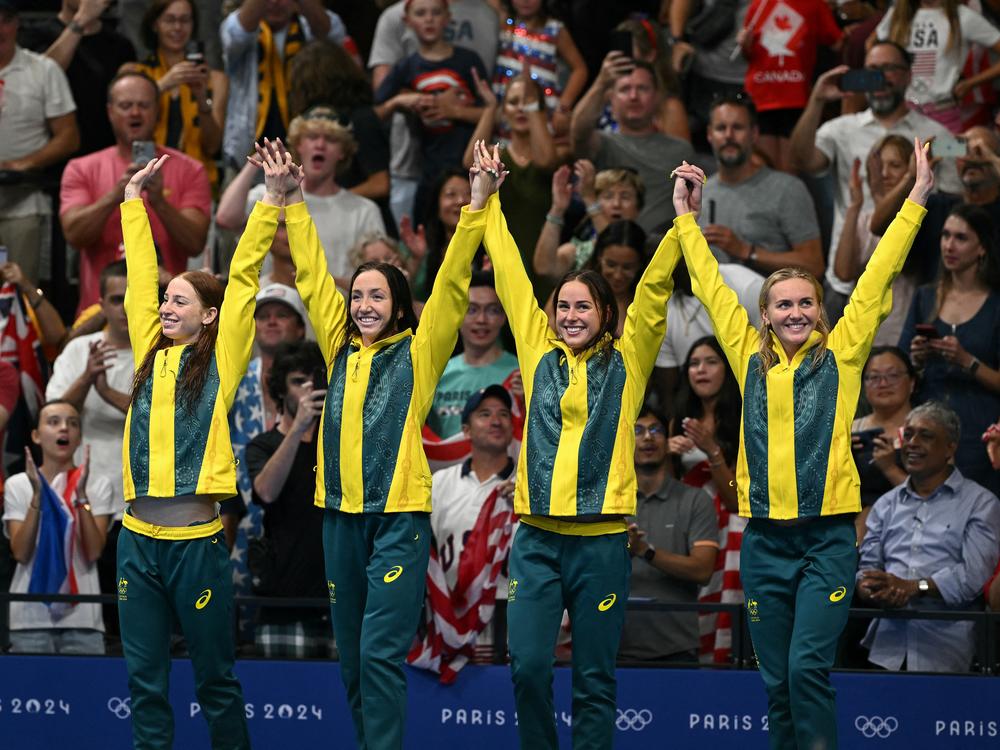Section Branding
Header Content
Is the Paris pool slow and shallow? Experts say it’s not only about depth
Primary Content
NPR is in Paris for the 2024 Summer Olympics. For more of our coverage from the games head to our latest updates.
Swimming is producing electric moments at the Paris Olympics. But the races aren’t generating world records at the pace seen at previous Olympics, leading to an awkward question: Is the pool a problem?
The dearth of world records seems to be swimming’s only snag at the Paris Olympics. Fans' excitement is boosted by more international parity — a trend many non-gold-winning U.S. swimmers can attest to. But in one event after another, world records were left intact.
Reports quickly emerged that the pool inside La Défense Arena is a bit on the shallow side. At roughly 7 feet, it met World Aquatics’ standards when it was designed. But as of last year, the governing body began calling for deeper Olympic pools, from 2.5 to 3 meters (8.2 to 9.8 feet).
“Slow pools are more shallow,” Gemma Fleming, a former world record holder who swam in two Olympics for Team Great Britain, tells NPR. And shallow means more turbulence.
But is it as simple as that? And should swimming fans be expecting more world records to be broken? To find out, we asked Fleming and other experts, including an Olympic pool builder.
What makes a pool fast?
Some pools are simply faster than others — people still talk about the Beijing 2008 Olympics having a very fast pool, for instance. And no, it doesn’t depend much on the water: A famous study concluded in 2004 that swimmers were just as fast in a pool filled with syrup as in one holding water.
You can get a sense of a pool’s speed just by looking at it, according to Kevin Post, the CEO at Counsilman-Hunsaker, the official aquatic designers for USA Swimming.
“If you walk in in the morning and you see that it just looks like glass, it looks like the water is not moving at all — that would be considered a fast pool," Post tells NPR. "And the quicker you can get back to that moment of quiescence where it's all nice and calm and quiet, the faster the pool.”
Turbulence is the big factor, confirms Fleming, who is now the aquatic program director at Florida Aquatics Swimming & Training, a complex better known by its acronym: FAST.
“The deeper the pool, the less turbulence there is between the bottom of the pool and the swimmer,” she says, adding, “More turbulence means more waves and makes being streamlined in the water harder.”
As designers try to minimize waves, Post says, “The things that we consider are water depth, the lane lines themselves and the gutter system.”
So, is the Paris pool slow?
“The depth is 2.15 meters at the Paris pool,” says Cole Henry, a project manager at Counsilman-Hunsaker. “The standard for World Aquatics used to be 2 meters to 3 meters in depth, with that 3 meters being preferred. So it's within the regulations of when it was designed.”
But other Olympic pools have been deeper. The pool from Atlanta 1996 is 3 meters deep, according to Georgia Tech, which still uses the facility. Pools from Beijing 2008, London 2012, and Rio 2016 were all reported at 3 meters.
"As many as 20 Olympic records ... were rewritten or made at Tokyo 2020," according to the Olympics website. As of Friday morning, 13 Olympic swimming records were broken, according to The Associated Press.
The Paris Olympics’ 50-meter pool was installed by the well-established Italian firm Myrtha Pools on the floor of La Défense Arena, which is normally home to a rugby team (earlier this summer, the venue also hosted a Taylor Swift concert). By making the pool less deep, designers saved a bit of extra room for seats.
Swimmers have said they have no complaints about the pool, noting that all the competitors are in the same conditions — and that the arena has been packed with fans every night.
What about world records?
With generational talents like France’s Léon Marchand and Team USA’s Katie Ledecky hitting the water, it’s natural to expect both Olympic and world records to tumble. But as of Friday morning, with three days of competition remaining, only one swimming world record had fallen at the Paris Games, as China's Pan Zhanle bested the record in men’s 100-meter freestyle that he set in February.
Fleming notes that swimmers have been trying for years to overcome world records set in 2008 and 2009 — and not only because of Beijing's fast pool.
"The Beijing Olympics was also on the cusp of the new tech suits, the year before lots of tech suits from 2009 were banned,” Fleming says. “Many records have not been broken, or only broken by tenths of a second, since 2009 as these high-tech suits set the bar very high.”
For his part, Post says people shouldn’t expect to see world records rewritten at an Olympics.
“There are faster meets in the year, which is where those world records are broken,” he says, citing time trials and championships. “Actually, I would say it's not that common for world records to be broken at the Olympics.”
Both Post and Henry note that in the past, swimmers have set world records in 7-foot pools. But they also say there’s another crucial factor affecting Olympic swimmers’ times, one tied to a different design requirement.
Hitting the wall is literally a problem
One of the best ways to dissipate swimmers' turbulence is to install gutters along all four pool walls, so water spills out rather than bouncing back toward the racers.
In an Olympic pool, regulations allow gutters on the end walls if they're covered by a grill or screen. But the rules also require a large touch panel on end walls.
“The international standard for World Aquatics is to have [about 12 inches] of the touchpad above the wall,” Post says. “For USA Swimming, that is not a requirement, and the touchpads are done at water level.”
“One of the downsides of international events is, they are absolutely slower pools because of that touchpad,” Post says.
That’s why the NCAA Championships is usually considered one of the fastest meets of the year, Post said: “Just because the U.S. has a lot of fast swimmers … and it's done in a pool that has gutters 360 degrees around the edge.”
How deep should an Olympic pool be?
“For the ‘96 [Atlanta] Games, our founders, Joe Hunsaker and Doc Counsilman, actually studied what impact the pools and waves can have on the swimmer,” Post says.
“They found that a swimmer carries about 5 feet of area of influence," he says, adding that pool depths were adjusted to reflect those findings and give swimmers smooth water.
But things have changed since 1996. Take Marchand, for instance: Even swimming legend Michael Phelps has remarked on how deep Marchand swims, submarining after his initial dive and after turns. With other swimmers also going deeper than before, Post says that with the next Olympics in mind, designers should consider how to account for deeper turbulence.
"Are we staying 5 feet away from any wall or anything at those moments?" he asks.





